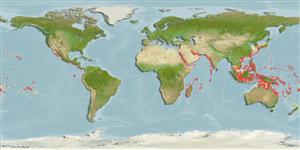Common names from other countries
Classification / Names / Names
Common names | Synonyms | Catalog of Fishes (gen., sp.) | ITIS | CoL | WoRMS
Environment: milieu / climate zone / depth range / distribution range
Ecology
Sessile. Tropical
Indo-Pacific.
Length at first maturity / Size / Weight / Age
Maturity: Lm ? range ? - ? cm
Found in the intertidal and subtidal reefs (Ref. 102518). Larger species feed by filtering plankton and organic particles from the water column while smaller species can pick up organic matter from the sediments and filter feed organic matter (Ref. 107862).
Life cycle and mating behavior
Maturity | Reproduction | Spawning | Eggs | Fecundity | Larvae
Members of the class Polychaeta are gonochoric (sexual), gametes are spawned through the metanephridia or body wall rupturing.
Fishelson, L. 1971. (Ref. 3565)
IUCN Red List Status (Ref. 130435)
CITES status (Ref. 108899)
Not Evaluated
Not Evaluated
Human uses
| FishSource |
Tools
More information
Age/Size
Growth
Length-weight
Length-length
Morphology
Larvae
Abundance
Internet sources
Estimates based on models
Preferred temperature
(Ref.
115969): 26.3 - 28.6, mean 27.4 (based on 122 cells).
Price category
Unknown.
